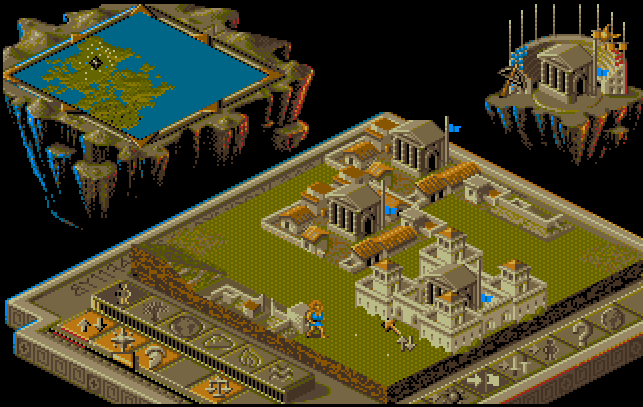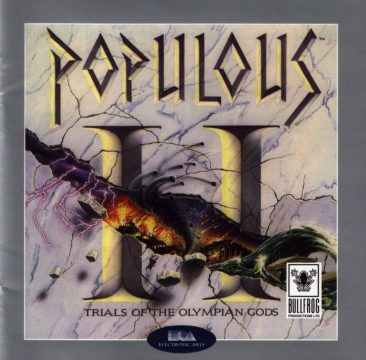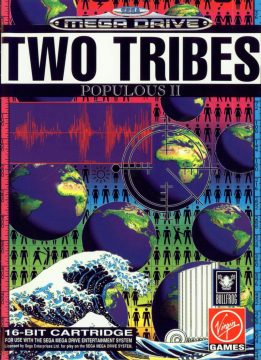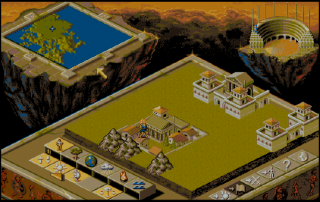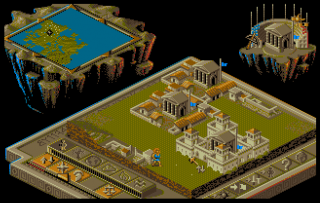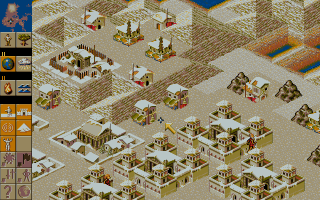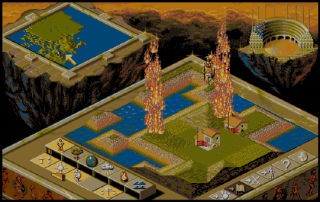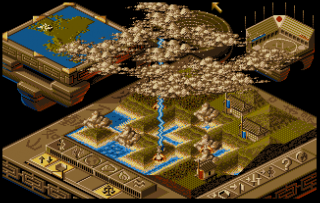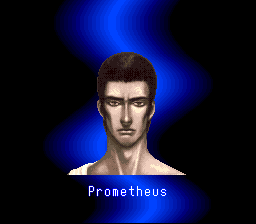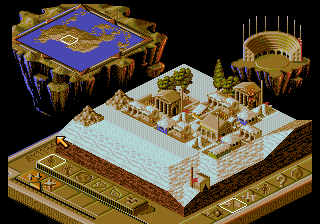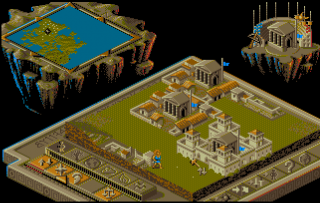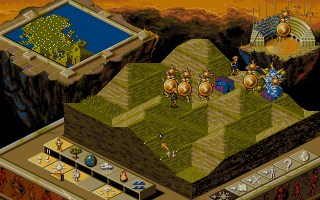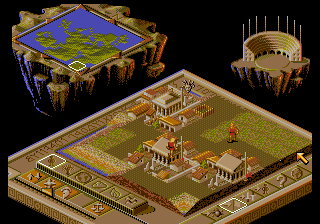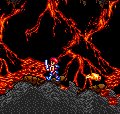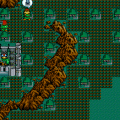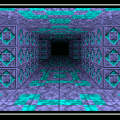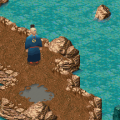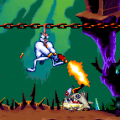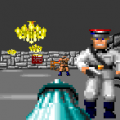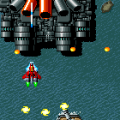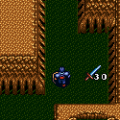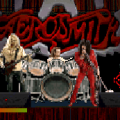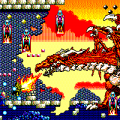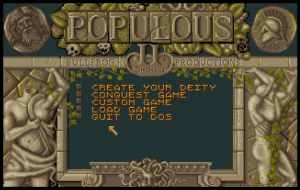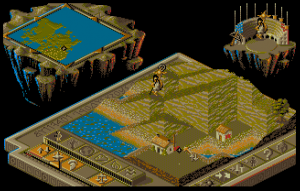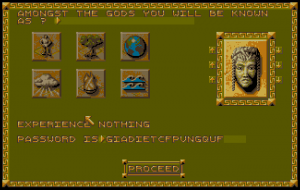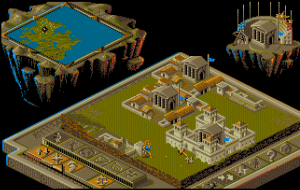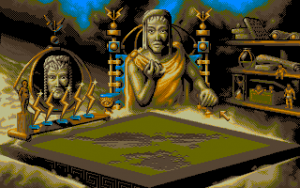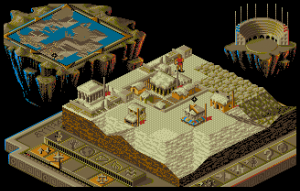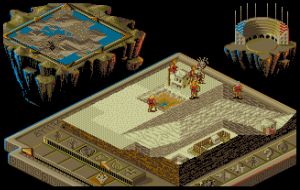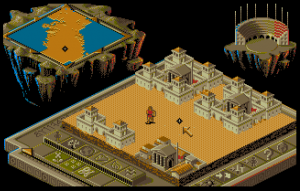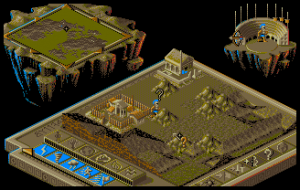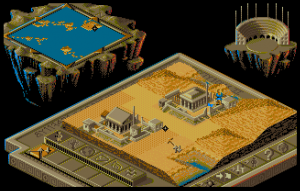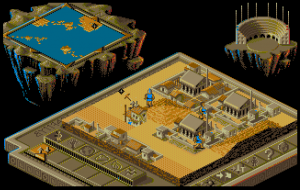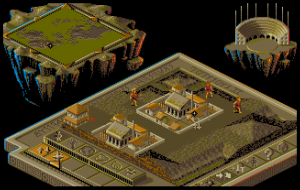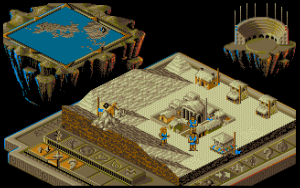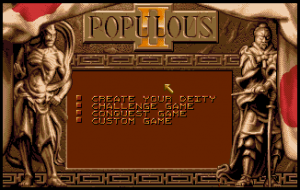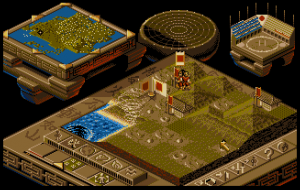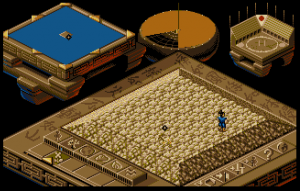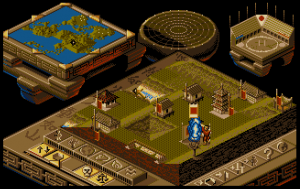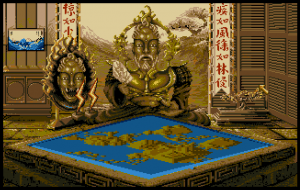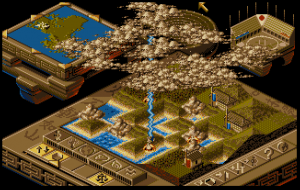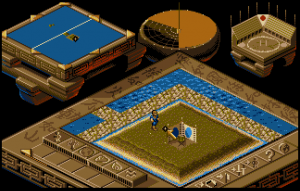With Populous, Bullfrog had unintentionally spawned a massive hit that would draw a new line in the ever-shifting sands of taste. And like any watershed moment, a feeling simmered in the atmosphere after Populous’s release that games, in their uphill climb towards artistic respectability, had tread new ground once more. That something as simplistic as Populous could excite these feelings, in retrospect, is difficult to imagine.
But the heart of ‘storytelling’ differs in each medium, and for video games, the dynamism of being a protagonist in a living, unfolding world – of influencing and leaving one’s mark on it – is what makes the narrative feel personal, first-person. Ironically, a game that offered less player input than usual seemed to tickle this fancy better than any game with delusions of minute, infinitesimal control ever could. Perhaps because the world itself, which games often mimic in a sort of inverted mirror, is itself a massive simulation, which requires nudging, fine-tuning, and occasional upheavals to set on course.
To his credit, Molyneux grasped this much earlier than most of his contemporaries, and once the sales figures started rolling in, it quickly became apparent that this was only the first round of something that would take time to perfect. As such, plans for Populous II began almost as soon as the first game hit the presses. Molyneux bragged to The One that it would be a total rewrite, not just another “data disk”, and could even include riffs on different mythologies, with expansions modding the game to include Celtic, Norse, and Japanese deities (only the latter ever materialized). Previews salivated over the possibilities, including the illusory Sim City connection, and speculated in terms no doubt subtly suggested by Molyneux himself about sprawling cities, uncountable game modes, orchestral music, and more. ACE Magazine even ran a reader contest (with a tinge of casual racism) which granted five lucky fans the chance to playtest the game at Bullfrog’s offices in Surrey themselves, drumming up hype even further.
All throughout, Molyneux maintained interest in Bullfrog’s antics with enigmatic statements about future games with codenames like ‘Project X’, ‘Creation’, and ‘Bob’. Working for Bullfrog looked like it would be any young upstart’s ticket to ride, and Molyneux made good on his promise to hire newbies through another contest in Amiga Power, which one Mike Diskett won with his entry Mr Wobbly Leg Versus the Invaders from Space (Diskett would end up leading on Syndicate Wars in 1996). Bullfrog found itself in a golden age of its own making, becoming a trend-setter and a rule-breaker in turn, cultivating an unorthodox ‘bad boy’ image in what was, after all, a business environment. And after topping Christmas charts with Powermonger in 1990, there was every reason to believe that upward trend would continue.
And so Populous II did indeed land with a bang – but it took awhile for the dust to settle. Upping the ante in every conceivable way, it is still today often thought of as the definitive Populous experience. But in the intervening years between the two games, other companies began to emulate its “3D isometric for-want-of-a-better-word ‘God-sim’ stuff” , in the words of Amiga Power, and some critics felt that derivative games like Mega lo Mania (Tyrants: Fight through Time for the U.S. Genesis port) had actually done the job better. Others felt that it was too similar to its predecessor to feel like a brand new experience worth the money.
Still, Populous II easily smashed it out of the park on its reputation alone, and received 90% or higher scores in every major games magazine of the time. It gave the Populous universe a coherent theme to work around, and proved to the industry yet again that Bullfrog wasn’t playing around. “Kiss your weekends goodbye,” wrote Trenton Webb ofAmiga Format in July 1991. “The game of the year is here!”
Populous II accommodates fans and newcomers alike happily, with a much cleaner interface than the first game and much faster processing speeds (“It runs at 17 frames per second, which is as fast as your average shoot ’em up”, Molyneux told The One excitedly). All essential game functions are the same as before, but this time, players find themselves cast as demigods in an actual pantheon – one of Zeus’s half-mortal children, sent to duke it out with the rest of their Grecian brethren for a seat at the heavenly table at Olympus. The game manual sports a well-drawn 4-page comic interpretation of this story, and is full of the cheekiness and bravado of a band of self-aware, popular virtuosos. Gary Carr’s staff profile lists ‘Margaret Thatcher’ as his “favourite TV monster” and Glenn Corpes’s life goal reads “Tetris – Level 16, depth 5.”
Casting Populous II in the ancient world with tropes familiar to most of its Western audience was a stroke of genius, allowing Bullfrog to pave over the uneven feel of the previous game and its confusing symbolism (the good “Papal Magnet” is an ankh; the evil one is a…skull?) with a consistent aesthetic design. The opening game menu is supported by statues flanking on either side, text appears chiseled into stone and border frames are filigreed with repeating patterns and Corinthian columns which adroitly evoke the setting. In-game, players will find their opponents to be increasingly-difficult incarnations of the myths of yore: Prometheus, Hermes, Athena, Apollo, and so on. And the style of peeps’ settlements appears to be a Greco-Roman mish-mash complete with pediments and Doric supports, which now sport clever visual cues like flags which raise or lower depending on the population inside, and grass ‘lawns’ to indicate their size of growth. There is even a (decidedly Roman) Coliseum in the upper-right hand corner which tracks global populations, another welcome addition to the base game.
But first, players must make a god of their own, choosing how to invest five initial experience points and the appearance of their character’s face. A quick aside on the latter: there is no point that this face appears to affect the game, other than an assurance in the manual and in all press of the time that it determines what kind of A.I. opponents players will face. According to the manual, whether the features chosen are “benevolent and wise, fierce and war-like, brutish and cruel, or some bizarre combination of these characteristics” will affect whether rivals are more directly confrontational or, in its own words, “more subtle and clever.” The problem, of course, is that no one has ever bothered to corroborate this little tidbit; if the feature is present, it is nigh-undetectable. And while it may be an example of incredibly ‘subtle’ programming, it is more likely an example of incredibly subtle marketing, Molyneux-style: planted like a time-bomb to go off far in the future when it no longer matters and affects sales.
As for the experience points, these represent the key difference between Populous and Populous II, replacing the endless Sisyphean climb of the first game with a continuity across maps. These points can be invested in six categories of ‘divine intervention effects’, which range from powers having to do with Man himself to all the natural elements – air, fire, water, and so on. At the start of the game, players will have access to a scant few powers, but by the time Zeus rears his giant, non-consensual perverted head, they will have developed a formidable arsenal. It is important to note, however, that experience points do not themselves open up new powers, but rather enhance powers that open up as players progress through the gauntlet of challenges.
Winning each map, then, not only affords players the right to skip levels (as in Populous), but anywhere from 0-5 experience points (represented by lightning bolts), depending on their performance. This is even less of a science than the facial conundrum, but it seems to reflect speed, max population, and a host of other variables – but most importantly, amount of interventions used; suffice to say that the design is solid enough that players usually know when they’ve done well, and their experience points should reflect that.
As such, players have the option to invest in certain ‘builds’ or become a jack-of-all-trades (at risk, of course, of being ‘master-of-none’). For example, raising and lowering the land – the core game mechanic which spawned Populous itself – is now merely one of several powers having to do with ‘Man’; after awhile, players will earn the right to lay down plagues, and with strong investment, both the bubonic terror and terraforming itself will be cheaper to deploy across the landscape. This game’s ‘Fire’ category puts the original’s to shame, as it includes blazing rain and proper (smoldering) volcanoes, which become deadlier and more persistent with more bolts invested. And as ‘Air’ lets you hurl hurricanes and storms and whirlwinds, more points here will lead to longer, more powerful gusts that throw peeps helplessly in circles (or lift your own over enemy walls).
All effects have organic properties to them which reveal themselves to the adept player. Heat naturally rises, and so columns of divine flame tend to move upwards; you can defend against this by ‘nippling’ a huge mountain to draw fire away. Tidal waves stop at basalt deposits, so a quick thinker can stop a monsoon in its tracks. And earthquakes are now fault lines rather than tremors which actually bifurcate the landscape and create perilous, snaking chasms in their wake.
Not all effects are created equal, however – and in the years since Populous II’s release, they have all been dissected beyond imagination and ranked somewhat objectively. So there are, indeed, fiddly mechanics marring this mythical cornucopia. But the sheer wonder experienced on the very first map when players realise that the lower-left intervention bar has enough slots for thirty different actions is irreplaceable – the scope, variation, and most of all experimentation possible is astounding. Actual gameplay confirms this, as no two runs of Populous II, start to finish, need be the same. And while experts can surely play with Civ-like precision, whittling down their improvement-path to linear, minimalist perfection, casual players will delight in trying something new every time they reboot Populous IIfrom the beginning.
More importantly, all of these elements now include their own variation on the ‘knight’ from the first Populous, with distinct ‘heroes’ that have real, strategic differences from one another: for example, Adonis (Vegetation) splits into two every time he wins a battle, creating a marauding army of gods relatively quickly, while Helen of Troy (Water) will simply lure walkers to follow her like a pied piper until they perish from starvation – and of course, Hercules (Earth) is simply the strongest of the lot. By investing experience points in each category, its respective leader becomes stronger as well, making the difference between a slow-moving god and one that zips across the map doing unspeakable things to break-away Greek city-states.
Populous II also offers peaceful, ‘civilization-building’ powers amongst the full range of horrors; now players can build roads, plant flowers and trees, and even city walls. It adds a nice touch to the game thematically, and gives players something to do during down-time in between major movements. But if it sounds a bit too good to be true, it’s because it is – while these powers certainly do produce some effect (mostly boosting the amount of manna received or renewing land ruined by other effects), their concrete benefits are not always immediately apparent, and so they usually fall by the wayside as more pressing matters of war are at hand.
Still, these ‘non-aggressive’ powers have a secondary, sinister use that mirrors the war doctrine of targeting ‘dual-use’ civilian infrastructure: as in real-life, damage to these sites can often be deadlier than a conventional bomb ever could be. So if players manage to erect some forests in enemy territory, their rivals may benefit from newly-green cities – but players can burn them later to create rapidly-spreading wildfires. Used wisely, city walls can cut off enemy peeps from approaching their own Papal Magnet (represented by a Medusa), and combined with the new ‘Baptismal Font’ power, which alters the allegiance of any peep who trips into its holy waters, whole legions of the red menace can be converted to the cause as they grope towards their inaccessible idol. Thus, even apparently non-violent wonders turn out to be better, in the end, for their violent uses. But moments like these show that in the depths of Bullfrog’s characteristic sadist-nihilism, they have always appreciated and rewarded player ingenuity: Populous II is a sandbox in the classical, rather than modern sense of the term, in that it gives players a small, finite world with a set of specific rules and then encourages them to go nuts.
It is worth noting that the Populous II’s complexity is quite a bit deeper than it may appear, and cannot be divined except by painstaking scientific method or resorting to FAQs. In this case, modern players should feel no shame in reading Chris Lee’s comprehensive FAQ, as no other existing resource offers the same depth or analysis of the game’s mechanisms. Full explanations of sprogging, hero powers, plague-spreading methodology, and experience point-investment are indispensable, as the manual only gives basic outlines at best. It is also revealing of the game’s confusing programming, as plenty of features remain obtuse and undeconstructed to this day.
Lee is also correct in advising players to use the new ‘Computer Assistant’ feature, following (in his words) the Chicago rules of voting – “early and often”. The assistant, which has some serious drawbacks, nonetheless terraforms at a swift rate and takes some of the tediousness out of initial gameplay. It is a welcome addition to what is ultimately a fiddly game, (despite all of its joyous, anarchic trappings), and can even be used by advanced players on particularly challenging levels. In Lee’s estimation, intelligent use of the assistant is actually a game mechanic in and of itself, though hardcore players may differ.
Bullfrog delivered on their promised Japanese mod in the form of Populous II: The Challenge Games in late 1992 only on the Amiga. As per usual, this expansion included 500 new worlds, a new divine intervention, and an aesthetic facelift rendering the game world in ancient Japan. The ‘Japanesque’ of the original Populous’s SNES release comes to life on the more detailed Amiga; cherry blossoms and pagodas proliferate, and subtle differences – like a throne instead of the Papal Magnet – are a novel distraction, if functionally identical. The new divine intervention, ‘Fire Burst’ is wickedly destructive and fun to use, but is too rare an indulgence to change the game’s mechanics substantially.
But it is the game’s eponymous challenge mode, giving the player 42 distinct puzzles to overcome using a restricted set of divine powers, that is its true draw. The first few challenges tend to consist of a lonely peep marooned on a single island with some sort of oncoming threat for which the player has around 30 seconds to react (marked by a sun dial set in between the mini-map and coliseum-cum-sumo–stadium in the upper right). These may consist of something simple, like an unwalled city being approached by an enemy hero (unsurprisingly, the solution is to erect a wall), or an oncoming tidal wave, but they naturally get more complex with each successive level. In one later challenge, the player must outmaneuver and outlive their opponent before two volcanoes erupt in their midst, and in another, players must guide their leader to the exit of a winding maze. These puzzles can become exceedingly harsh, sometimes giving a Wario Ware-like 1 or 2 seconds before ending, but they will give way to determined – perhaps masochistic – players with time.
As for the base game itself, it’s nothing to write home about. Curiously, despite the outward changes, heroes are still named by their original, Greek names, though they are clad in the kabuto and body armor of the ‘traditional’ samurai. In addition, the ‘sun dial’ of the challenge mode remains motionless and unused in the standard game, confusingly cluttering the screen. Lastly, the whole game suffers from long loading times, inexplicable given the almost identical structure and content to the base game. This kind of laziness should explain why the game’s reception was lukewarm in some circles –“standard expansion disk fare” in the words of Amiga Power. Looking at the game’s manual, it appears that none of the original team was involved, which is nothing new for expansions, but it certainly explains the inconsistent quality. Still, The Challenge Games provides some new novelties that make owning just the original game alone pointless, as the experience is naturally richer with all pieces included.
Like its progenitor, Populous II was quickly ported to all the systems of its day. It should be noted that originally, there were even two Atari ST versions – one with a smaller footprint containing fewer animations and sounds, and one with the full game, in order to accommodate consumers on the lower end of the spectrum. No other systems were granted The Challenge Games. Again, the Atari ST and Amiga versions are nearly identical, and other notable versions include the DOS and SNES ports.
We can start in reverse order with these. The SNES port is a severely truncated version of the base game, with only 48 levels played in sequential order. An overwrought ‘story’, complete with fully-drawn facial profiles and ‘cutscenes’ unfolds between levels, culminating finally in the battle with Zeus, set atop a floating set of islands in the clouds. Gameplay is hampered by the usual problems of computer-to-console conversions, but it is by no means unplayable, although it is missing the most powerful Fire intervention, Divine Fire (perhaps because it is more impressive than useful in actual gameplay).
The DOS port, while more complete, may not be for everybody. It is certainly more streamlined, thanks in large part to a refreshing fullscreen mode which finally gives players the scope to see beyond the usual restrictive map grid. However, a harebrained attempt at ‘improving’ the graphics leans on the cartoony side as characters strut around with golden-copper thighs worthy of Cho Aniki. Sound quality is debatable but certainly fuzzier in comparison to the Amiga, and it suffers from the same hyper-speed on modern machines as its predecessor, to the point of almost being unplayable – fiddling with slow-down is recommended. The opening menu is far less expressive than the Amiga’s, though it allows for saving and loading rather than the previous password system for deity creation. It also features a lengthy cartoon intro, displaying some of the divine intervention effects to a faux-cinema audience a la Mystery Science Theater 3000. As with the first Populous, Populous II’s MAC port is in all respects identical to this version.
The game was renamed Two Tribes: Populous II for its Genesis/Mega Drive port in Europe, and tentatively Wrath of the Gods in the U.S. (this latter version was never released, though evidence of prototypes has since surfaced). While the game as a whole feels slower than the original, actually scrolling around the map is much breezier. Accessing menus remains a chore as it involves executing fighting game-style inputs just to accomplish basic tasks, but this is the price of entry which players with physical copies will be more likely to accept than anyone with access to a home computer.
Playing Populous is a bit like herding cats. It is an alchemy of movements rather than a science of specific maneuvers; an act of trust in wayward, uncooperative A.I. and not a fantasy of architectonic control. Despite the simplicity of its design, there is something radical in this displacement that took gamers a long time to wrap their head around, so bold and unfamiliar was the concept. But the sensation was inevitably a waning one in the first game, as it often boiled down to using divine interventions merely to stave off enemies long enough to produce a few knights.
Populous II doesn’t change this fundamental formula per se – but it does create enough variety to make heroes only one piece of a much larger strategy. Sending out a Perseus or Helen of Troy may indeed be the clincher in a heated match, but only in so far as the civilization they represent can withstand all the twisted new maladies its opponents can throw at it. Busier and livelier than its progenitor, peeps sprawl out on the landscape in twisting, city-like settlements that evoke something of a real world that exists beyond player concerns. And so in this sense, Populous II is all about building and perfecting micro-engines, not simply total annihilation, bringing Bullfrog’s flagship series as close to its simulation roots as it ever would be before or after. Coupled with a refined graphical style and a well-paced difficulty curve, it simply makes the original Populous look like a prototype.
So despite grumblings over the caliber of this sequel – perhaps in part due to the expectations built up by Molyneux’s own relentless pie-in-the-sky speculative game design confidentials – it was hailed variously as the “game of the nineties”, the “best 16-bit computer game”, and “more playable than all pretenders to the throne”, and deservedly so. Populous II remains fresh and vital to this day, and stands as a testament to the heyday of Bullfrog’s design philosophy. And while the premise is less heady than the later Black & White, it is a crucial stepping stone in Molyneux’s own growth as an artist while still being a gamer’s game: fast-paced, challenging, layered, huge. For an era that did not yet have mega-FPS tournaments, thriving online RTS communities, or MMOs, Populous II hit on something special, which led Matt Bielby to speculate – perhaps prematurely – that it was “about the closest computer games have come to a genuine competitive sport”. Either way, it carried the torch of the series honorably forward and silenced any doubt that the god game was a mere passing fad. Bullfrog would continue to experiment with elements of their divine revelation in the likes of Syndicate and Dungeon Keeper, but Populous itself would not return for another seven years; by then, Molyneux would be out of the picture and at the helm of a new studio, and the series would take a decidedly different turn in his absence.
Links:
Populous and Powermonger cover gallery Lots of comparison shots between versions
The Rise and Fall of Peter Molyneux Kim Justice’s thorough 5-part documentary
Screenshot Comparisons
